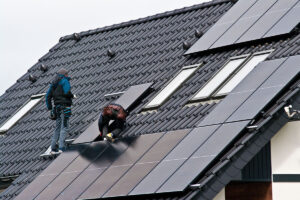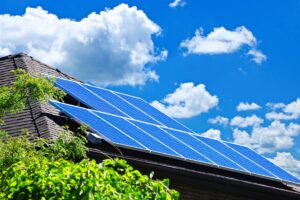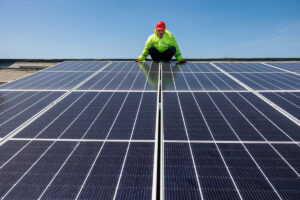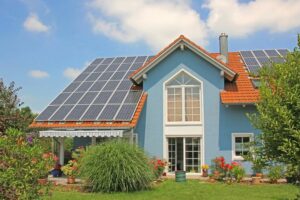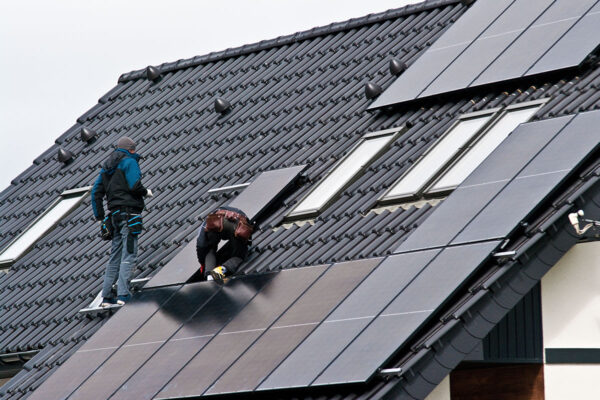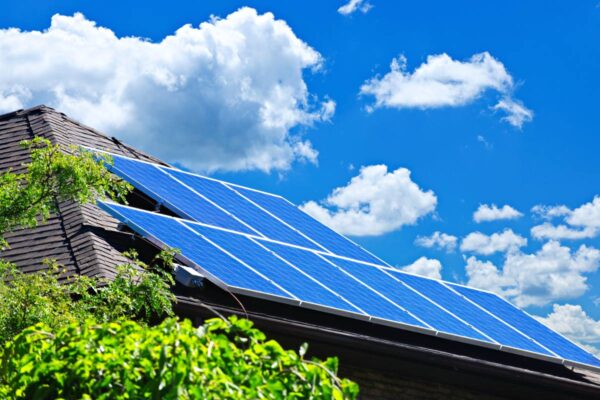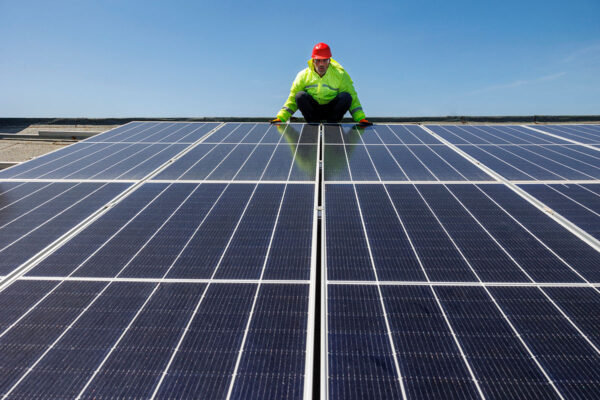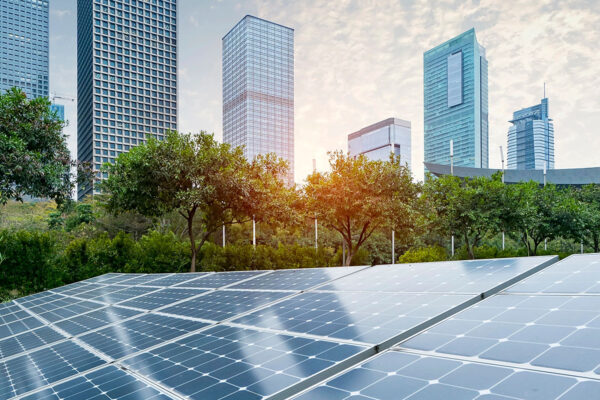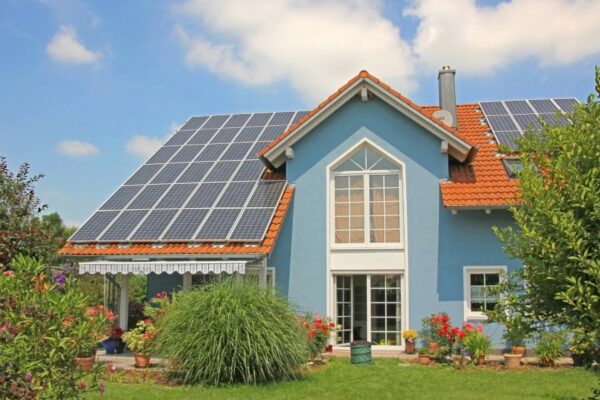Solar energy is a leading sustainable power source, using the sun’s abundant energy to reduce dependence on fossil fuels. Solar roof installation in Austin has become a popular option for homeowners, providing significant financial savings and environmental benefits.
Below, you’ll learn about Austin solar options and factors to consider:
- The advantages of solar energy
- How to assess your home’s suitability for solar
- Step-by-step details of the installation process
- Financing options for your solar project
Understanding Austin Solar Energy and Its Benefits
Solar energy is a clean energy option that stands out from other sources of energy. It has a significantly lower impact on the environment compared to fossil fuels. By using solar power, we can reduce greenhouse gas emissions and combat climate change.
The Environmental Benefits of Solar Energy
When you choose solar energy, you’re making a positive impact on the planet. Here are some ways solar energy benefits the environment:
- Reduces Air Pollution: Unlike traditional power plants that burn fossil fuels, solar panels generate electricity without releasing harmful pollutants into the air.
- Conserves Water Resources: Solar energy production requires minimal water compared to conventional power generation methods, such as hydroelectric or thermoelectric plants.
- Decreases Dependence on Non-Renewable Resources: By harnessing the sun’s energy, we can reduce our reliance on finite resources like coal, oil, and natural gas.
The Financial Benefits of Solar Energy
Solar energy also offers significant financial benefits. Here’s how going solar can save you money:
- Lower Electricity Bills: With solar panels installed on your property, you can generate your own electricity and reduce your reliance on the grid. This means lower monthly utility bills.
- Potential Tax Incentives: Depending on where you live, there may be tax credits or rebates available for installing solar systems. These incentives can further offset the cost of your investment.
- Increased Property Value: Studies have shown that homes with solar panels tend to sell at higher prices compared to similar properties without them. Investing in solar not only saves you money but also adds value to your home.
The Long-Term Value of Solar Systems
Investing in solar technology is not just about immediate savings; it also holds long-term value. Here’s why:
- Protection Against Rising Energy Costs: As energy prices continue to rise over time, having a solar system allows you to produce your own electricity and shield yourself from these escalating costs.
- Durability and Longevity: Solar panels are built to last for decades with minimal maintenance required. This means once you’ve paid off your initial investment, you’ll enjoy free electricity for many years.
The benefits of going solar encompass environmental stewardship, financial savings, and long-term investment value. Each aspect contributes to making solar an appealing choice for homeowners aiming for sustainability and financial efficiency.
Evaluating Your Home for Solar Suitability
Assessing your roof suitability for solar panels is crucial for a successful installation. Several key factors influence this assessment:
- Age of the Roof: An older roof may require repairs or reinforcement before solar panel installation.
- Integrity: Ensure the roof is structurally sound and free of leaks or damage.
- Orientation: South-facing roofs capture the most sunlight, while east and west-facing options can still be viable.
Ideal roof characteristics enhance energy production:
- Slope: A pitch between 15 to 40 degrees is optimal for solar panels, allowing for effective sunlight capture.
- Shading: Minimize obstructions like trees or chimneys that can cast shadows on the panels.
Sunlight exposure plays a pivotal role in energy generation. The more direct sunlight your panels receive, the greater their efficiency and output, making proper roof assessment essential before moving forward with installation.
The Solar Installation Process
Securing Necessary Permits and Inspections
Preparing for solar panel installation involves navigating the regulatory landscape of your local area. Understanding local regulations is crucial. Each municipality has specific guidelines regarding solar installations, which can vary significantly from one place to another. Here’s what you need to know:
- Permitting Requirements: Most regions require homeowners to obtain permits before proceeding with solar installations. This may include building permits, electrical permits, and possibly zoning approvals. Familiarize yourself with your locality’s requirements early in the process.
- Scheduling Inspections: After securing the necessary permits, inspections will be required at various stages of the installation. These inspections are conducted by local authorities to ensure compliance with safety and building codes.
To effectively manage permitting and inspections for solar, consider these steps:
- Research Local Regulations: Visit your local government’s website or contact your city planning department to understand the rules governing solar installations.
- Compile Documentation: Gather all necessary documents, including site plans, installation designs, and any other paperwork that may be required.
- Submit Permit Applications: Complete and submit your applications along with the required fees. Ensure accuracy to avoid delays in approval processes.
- Schedule Inspections: After receiving permits, coordinate with local authorities to schedule inspections at key points during the installation.
Choosing the Right Mounting System
Selecting the appropriate mounting system is crucial for your solar panel installation. Here are key considerations:
1. Types of Mounting Systems
- Roof-mounted: Common for residential use, these systems utilize the roof’s structure for support.
- Ground-mounted: Ideal for properties with ample land, these systems allow flexibility in positioning.
2. Influencing Factors
- Stability: Ensure the chosen system can withstand environmental conditions.
- Longevity: Consider durability against weather exposure and maintenance needs.
3. Cost-effectiveness
Roof-mounted systems often provide a more economical solution for homeowners, minimizing additional installation costs.
Proper preparation includes gathering tools and equipment necessary for installation, adhering to manufacturer’s guidelines to ensure safety and efficiency. Understanding local regulations and permitting requirements is essential before proceeding.
Installation Steps
Preparation is key when you embark on the journey of solar panel installation. Thorough preparation ensures safety and efficiency throughout the process.
1. Gather Tools and Equipment
- Solar panels
- Mounting hardware
- Power tools (drill, saw)
- Safety gear (gloves, goggles)
- Measuring tape and level
2. Understand Local Regulations
- Research your area’s requirements for permitting and inspections for solar installations.
- Ensure compliance with HOA guidelines if applicable.
3. Follow Manufacturer’s Guidelines
- Adhering to manufacturer instructions promotes safety and optimizes system performance.
- Pay attention to specifications regarding installation techniques, wiring, and equipment handling.
4. Prepare Your Installation Area
- Clean the roof surface thoroughly before starting.
- Check for any obstacles that may hinder panel placement or wiring access.
Mounting System Installation
Prepare for solar panel installation by gathering essential tools and equipment. Adhering to local regulations is crucial, including obtaining necessary permits and scheduling inspections for solar. Thorough preparation ensures a smooth process, emphasizing safety and efficiency.
Key Steps in Mounting System Installation
- Marking bracket locations: Accurate placement is vital for optimal panel positioning.
- Ensuring roof integrity: Install flashing and seals to protect the roof during installation.
- Securing brackets/rails: Proper alignment guarantees stability and longevity of the mounting system.
Attaching Solar Panels
Preparing for solar panel installation requires gathering the right tools and equipment. This step is crucial for ensuring safety and efficiency during the process. When attaching solar panels, follow these guidelines:
- Lifting Panels: Carefully lift each panel onto the rails, adhering strictly to manufacturer instructions to prevent damage.
- Securing Panels: Use clamps and brackets to secure panels effectively. Ensure each connection is tight and stable to withstand environmental factors.
- Connecting to the Inverter: Properly connect the panels to the inverter for DC to AC conversion. This step is essential for your solar system’s functionality.
Thorough preparation and adherence to local regulations, including permitting and inspections for solar, will facilitate a smooth installation process.
Finalizing the Installation
Completing the installation of your solar panels involves essential steps that ensure everything functions effectively and safely. Preparation before installation is crucial, as it sets the foundation for a successful project.
Key Steps to Finalize Solar Panel Setup:
- Gather Tools and Equipment: Before you begin, assemble all necessary tools, including:
- Drill and drill bits
- Wrenches
- Level
- Safety gear (gloves, goggles)
- Electrical tools for wiring connections
- Follow Manufacturer’s Guidelines: Adhering to the manufacturer’s instructions guarantees safety and efficiency. This includes:
- Verifying all connections are secure
- Ensuring proper wiring access and routing
- Checking that components meet local regulations and codes
- Conduct Inspections: After securing your panels, perform an inspection of:
- All wiring connections and fasteners
- The protection of wires from weather elements
- Overall structural integrity of the installation
- Activate the Inverter: Once everything is checked, activate the inverter to start converting DC power to AC power.
Properly finalizing your installation not only enhances performance but also aligns with local regulations regarding permitting and inspections for solar energy systems.
Understanding Solar Financing Options
Solar Tax Credits and Incentives
Navigating the financial landscape of solar energy can be daunting. Understanding available tax credits and incentives is essential for maximizing your investment in solar technology. Here are key components to consider:
1. Federal Investment Tax Credit (ITC)
This program allows you to deduct a significant percentage of the installation costs from your federal taxes. Currently, the ITC offers a 30% deduction for systems installed by the end of 2023, which can significantly reduce upfront costs.
2. State-Specific Incentives
Many states offer their own incentives that can complement the federal ITC. These may include:
- Rebates: Some states provide direct rebates based on system size or installation costs.
- Performance-Based Incentives (PBIs): These incentives pay you based on the actual electricity generated by your solar system over a specified period.
3. Net Metering
This allows homeowners to receive credit for excess energy produced by their solar panels and fed back into the grid. When your system generates more power than you use, these credits can offset your utility bills during times when energy production is lower.
4. Property Tax Exemptions
In many jurisdictions, solar panel installations are exempt from property tax increases. As your home value may rise with the addition of solar panels, this exemption ensures you won’t face higher taxes as a result.
5. Financing Options
Various financing programs make solar installations more accessible:
- Solar Loans: Many banks and credit unions offer loans specifically for solar installations with competitive interest rates.
- Leases and Power Purchase Agreements (PPAs): If upfront costs are a concern, leasing systems or entering into PPAs allows you to use solar energy without large initial investments. You pay a monthly fee or purchase power at a set rate.
6. Community Solar Programs
If your roof isn’t suitable for solar panels, community solar programs provide an alternative. By investing in shared solar projects, you can still benefit from solar energy without needing personal installation.
Understanding these financing options enables you to make informed decisions about going solar. Each incentive and program play a vital role in lowering costs and enhancing the financial viability of installing solar panels on your home.
Researching specific programs applicable to your state or locality is crucial. A thorough examination of available resources will guide you towards making sound financial choices while embracing renewable energy solutions.
Embracing a Solar-Powered Future: Your Next Steps
Starting your journey with solar energy is an important step towards being environmentally friendly and saving money. We’re here to make sure you have the fundamentals and ensure you’re ready for a successful Austin roofing and solar project.
Here are the main points to remember:
- Understanding Solar Benefits: Knowing the positive impact of solar energy on the environment and your finances helps you make better choices.
- Evaluating Roof Suitability: Looking at factors like how old your roof is, its condition, and which direction it faces ensures that your solar system works efficiently and lasts a long time.
- Navigating Regulations: Getting the right permits and understanding local rules makes the installation process smoother and faster.
Using solar panels and batteries in Austin can lower your electricity bills while helping create a cleaner planet. By following this guide, you’ll be able to tackle each step of the installation with confidence and steer clear of common mistakes.
As you think about switching to solar, keep in mind that there are resources out there to help you. Discuss your options with reputable solar contractors in Austin, such as the team at Divided Sky, to make sure to take advantage of tax credits and incentives to boost your investment. Moving towards renewable energy is a vital part of creating a sustainable future.
Make the decision today to lead yourself towards successful solar energy adoption and reap its rewards!
Frequently Asked Questions About Solar Roofing
What are the main benefits of installing solar panels in my home?
Installing solar panels offers numerous benefits, including significant financial savings from reduced electricity bills, a decrease in your carbon footprint, and an increase in your home’s long-term value. Solar energy is a clean and renewable power source that contributes positively to the environment.
How can I determine if my roof is suitable for solar panel installation?
To evaluate your roof’s suitability for solar panels, consider factors such as the age and integrity of the roof, its orientation and slope, and any shading from nearby trees or buildings. Ideally, a roof should have a south-facing orientation with minimal shading to maximize sunlight exposure for energy production.
What steps are involved in the solar panel installation process?
The solar panel installation process includes several key steps: assessing your roof for suitability, securing necessary permits and inspections according to local regulations, choosing the right mounting system, installing mounting brackets, attaching the solar panels to the brackets, connecting them to an inverter, and finalizing the setup.
What permits do I need before installing solar panels?
Before installing solar panels, you need to obtain specific permits based on local regulations. This typically involves submitting an application to your local government or building department. Utilizing tools like the National Renewable Energy Laboratory’s SolarTRACE can help estimate timelines for obtaining these permits.
What types of mounting systems are available for solar panels?
There are primarily two types of mounting systems for solar panels: roof-mounted and ground-mounted systems. Roof-mounted systems are often more cost-effective for residential use due to their stability and longevity. The choice of mounting system will depend on factors such as available space, stability requirements, and cost considerations.
Are there financial incentives available for installing solar energy systems?
Yes, there are various financial incentives available for homeowners who install solar energy systems. These may include federal tax credits, state rebates, and local incentives that can significantly reduce the overall cost of installation. It’s advisable to research current incentives in your area to maximize savings.


